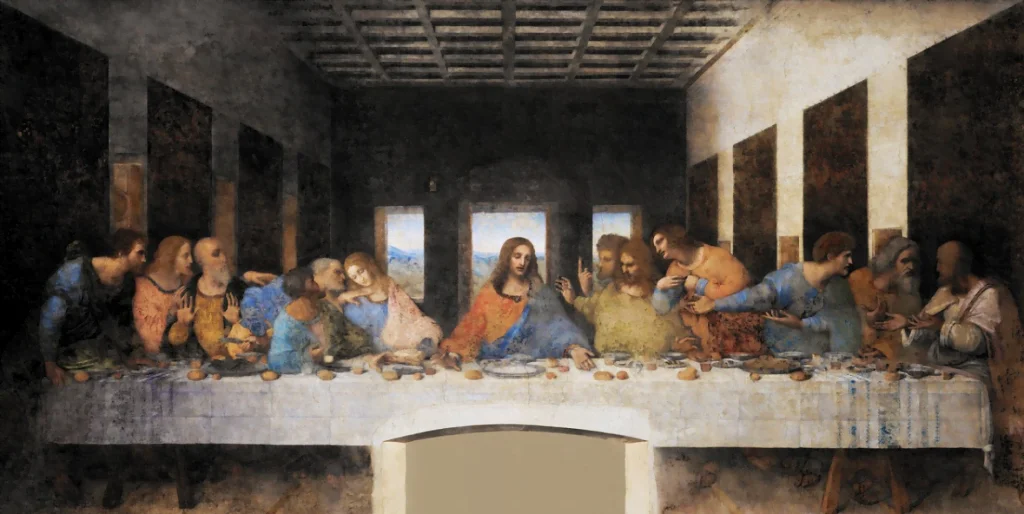It’s without a doubt one of the most recognized paintings of all time, created by the ultimate polymath in history.
In this post, You’ll discover the ultimate list of facts about the Last Supper Painting, one of the best-known Renaissance paintings ever produced.
1. The Last Supper has an illustrious painter
The Last Supper was created by one of the most talented individuals to have ever lived, Leonardo da Vinci. He is most known as a painter, but he was a true polymath of the renaissance in every sense of the word.
He was born in the region of Florence, Italy, halfway through the 15th century, and despite being so talented, he has been described as both the “Renaissance Man” and the ultimate example of procrastination and distraction.

2. It’s one of the most copied paintings ever
Have you ever seen a copy somewhere of The Last Supper painting hanging in somebody’s home or in a store?
Chances are you have, as it’s one of the most copied religious paintings in history, which in return makes it one of the most recognizable paintings in the Western world as well.
3. It’s much bigger than you would expect
The copy you have come across will without a doubt be no match for the original. And we’re not just talking about the stylistic elements of the painting.
The painting measures 460 cm × 880 cm (180 in × 350 in), which is way too big to hang on your living room wall, unless you want to cover the whole thing (and even then, chances are high it wouldn’t even fit).
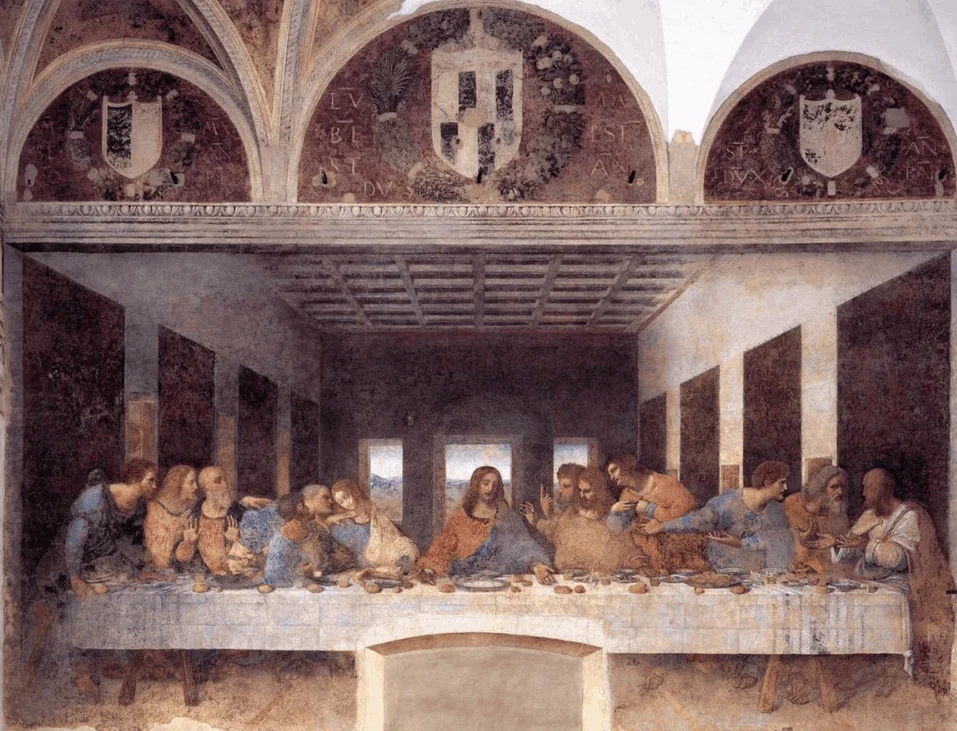
4. Where is The Last Supper located?
As you have surely noticed from the above image, or if you have read our list of most valuable paintings in museums, in which it would obviously have been included, the painting isn’t located in a museum.
It’s a mural painting which means its permanent home is the place where it was actually painted. This is the dining wall of the Convent of Santa Maria Delle Grazie in Milan, Italy.
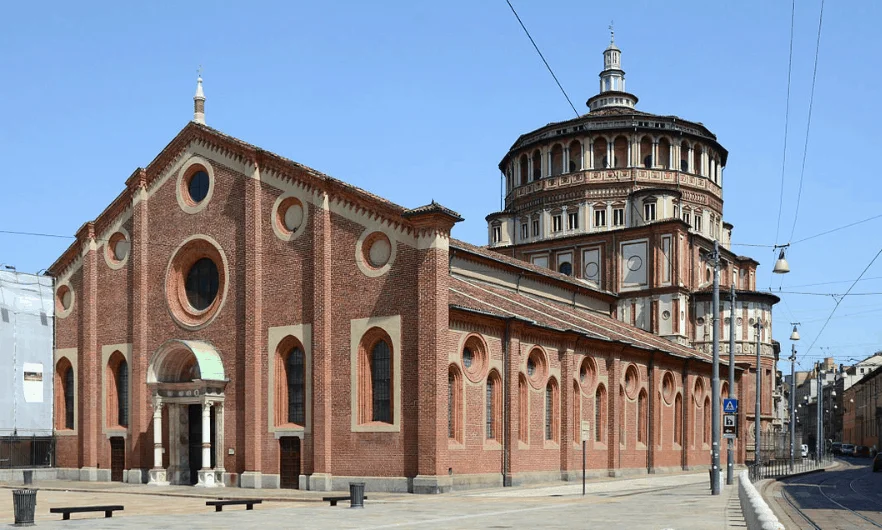
5. Why was The Last Supper painted?
The painting was commissioned in the 1490s by the Duke of Milan, Ludovico Sforza also referred to as Ludovico Il Moro.
His initial idea was to turn the original church, which was completed in the 1480s, into a family mausoleum. He commissioned the painting to serve this purpose.
These plans, however, were never completed and only a small mortuary chapel was built adjacent to the cloister. The Last Supper was eventually painted on the wall of the refectory (dining hall) of the convent.
6. The “lunettes” reflect its commissioner
Have you ever wondered what the “lunettes,” the half-moon-shaped spaces formed by the ceiling, above the painting depict?
These portray the coats-of-arms of the “House of Sforza” to which the Duke of Milan, Ludovico Sforza, which was also the commissioner of the painting, belonged.
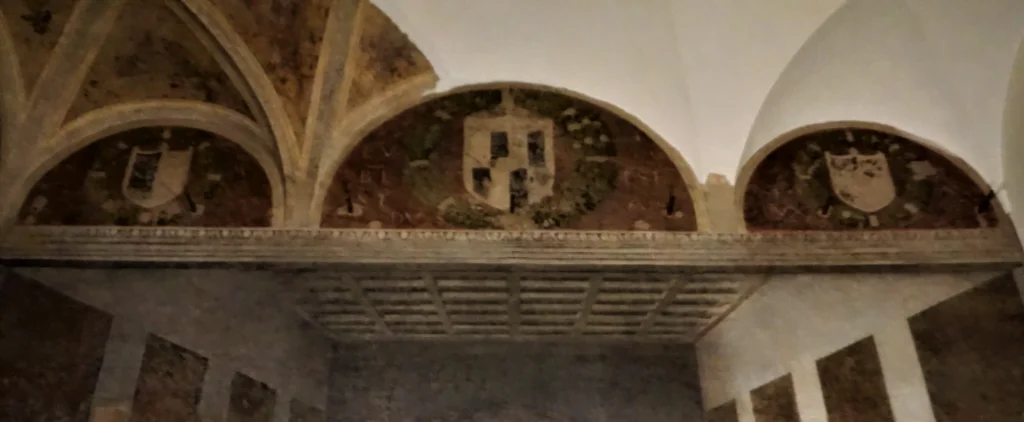
7. It’s not exactly sure when it was painted
Since the records of the convent of the period that The Last Supper was created have been destroyed, it’s unknown when the painting was exactly started. Assumed is that it was painted between 1495 and February 9, 1498.
What we do know is that, according to one surviving document, the painting was nearly completed in 1497, but as usual, Da Vinci was procrastinating, presumably because he couldn’t figure out how to portray Judas.
8. He got his inspiration for Judas in the right place
Leonardo da Vinci was a peculiar man. His genius surpassed the average mortal by miles, but yet he had the tendency to easily get distracted and procrastinate to the point of simply not finishing what he started.
In the case of the Last Supper, finding the perfect face for the treacherous Judas seemed to be what put him off, so he went to the one place he would surely find the inspiration he needed: the Milan jail.

9. The Judas Anecdote
Most of the time Da Vinci was a calm and reserved man, very well-liked by most people who hired him for his numerous talents.
The Judas episode and subsequent delay seemed to have annoyed one of the priors in the monastery where he was painting The Last Supper, urging him to finish the job.
Clearly enraged by the warning he received, he wrote a letter back to the head of the monastery. In it, he explained his trouble with finding inspiration to depict Judas, and if he couldn’t find it in time, he would use the prior who had complained as a model for Judas.
There were no more recorded complaints after this incident.
10. Da Vinci used an experimental technique
The technique consisted of applying an undercoat of white lead and using tempera paints on a dry plaster wall. Normally, frescos are painted on wet plaster walls which makes it more likely for the paint to sustain the conditions of humidity.
His experiment eventually proved to be unsuccessful.

11. Why didn’t he just use the standard technique to paint a fresco?
The standard technique of creating a fresco was to add multiple layers of plaster before and during the painting. This required for it to be painted fast.
Leonardo, however, didn’t like to paint fast and wasn’t very experienced with fresco painting, which is why he tried an experimental technique that would allow him to move along slowly and make a lot of changes in the process.
Had he been allowed to create the painting with oil on canvas, it would have been in perfect condition today!

12. Not much remains from the original
When Leonardo da Vinci started the work, the church was actually being rebuilt according to the plans of Sforza. because this was done hastily, the walls were filled with rubble that had a pre-condition to moisturize them.
This completely unsuited wall made the effects of humidity be felt instantly. As a result, the paint started to flake shortly after it was finished on February 9, 1498.
13. The location of the convent isn’t ideal as well
On top of the already existing bad conditions such as a bad wall and experimental technique applied by Da Vinci, the Santa Maria Delle Grazie Convent is located in a low part of the city of Milan.
This part of the city is prone to flooding and dampness, which made it even more likely for the fresco to be subject to humid conditions that made it deteriorate rather quickly.

14. The painting became a complete ruin
Because the paint had started to flake just years after it was completed, it was barely recognizable decades later.
In 1532, Gerolamo Cardano, another Italian polymath, described it as “blurred and colorless compared with what I remember of it when I saw it as a boy.”
Just 60 years after it was finished, Italian historian Giorgio Vasari wrote that the painting had deteriorated in such a way that it resembled a “muddle of blots, so deteriorated that the figures were unrecognizable.”
15. What position were Jesus’ feet in?
Halfway through the 17th century in the year 1652, a doorway was cut to allow easier access to the refectory in the location where Jesus’ feet were depicted.
What seems irrational now probably wasn’t at this time. A century after the painting was described as a complete ruin, none of the figures would have been visible at all.
It is however believed that Jesus’ feet were depicted in such a way that their position symbolized the forthcoming crucifixion.

16. Napoleon’s troops didn’t care much for Da Vinci’s work
During the French Revolution in the year 1796, under the command of Napoleon Bonaparte, French forces took command of Milan and turned the refectory of Santa Maria Delle Grazie into an armory and stables.
The anti-clerical revolutionaries didn’t care much for religious art, so they frequently threw rocks and dirt at the painting, as well as deliberately damaging it.
17. The painting was severely damaged during WW II
Even though preventive sandbagging had been put in place in order to protect the painting from bomb splinters, it didn’t help for the painting to be completely destroyed, yet again.
During an Allied bombing, the sandbags had protected the painting, but vibrations caused by the bombing caused significant damage. This happened on August 15, 1943.
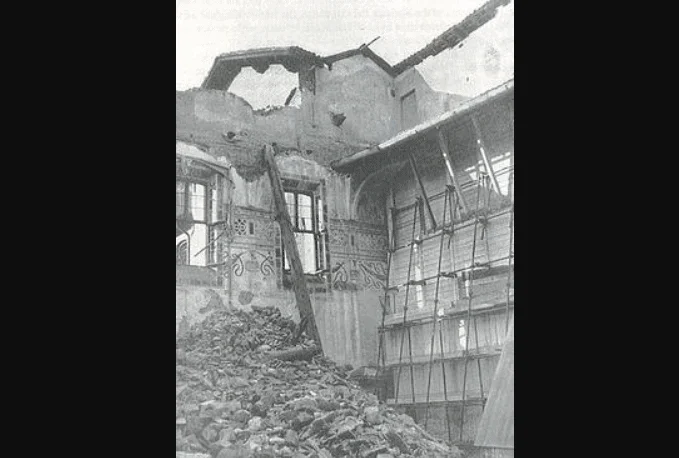
18. Many restoration efforts have been proven unsuccessful
In the past centuries, many restoration attempts were initiated, but none of them have been very successful.
Why was that?
The main reason most of the restoration attempts of the painting were unsuccessful was that the painters didn’t know it actually wasn’t a fresco.
The only thing that could be done was to slowly remove all paint and oil from previous attempts as a way to restore The Last Supper back to its old glory.
19. What’s the current status of The Last Supper?
The final restoration attempt started in 1978 and lasted over 2 decades, finally being completed after 21 years on May 28, 1999.
Art conservator Dr. Pinin Brambilla Barcilon was the person to lead the delicate operation. First of all, the refectory was converted to a sealed, climate-controlled environment that would prevent further damage to the painting.
Detailed studies were then undertaken to determine the original form of the painting, and it was slowly but surely recreated to resemble the original as closely as possible.
So one of the most interesting facts about The Last supper painting is that the current version wasn’t actually painted by Leonardo Da Vinci.
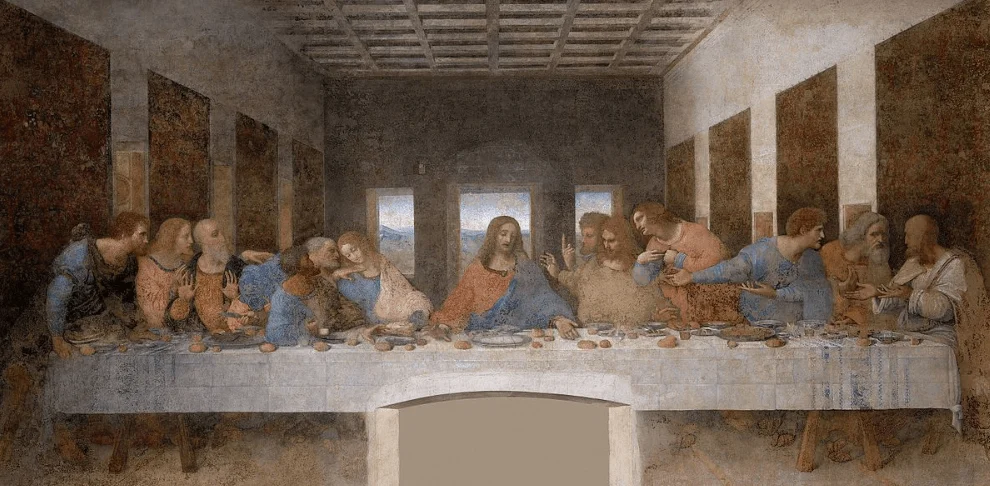
20. It depicts a moment of high tension
So what does the Last Supper Painting depict?
It shows us the moment just after Jesus told the 12 Apostles that one of them would betray him. The painting is created in such a setting that it literally invites you to join the discussion.
Each Apostle seems to have a different reaction, and only one seems to know the news already, Judas.
Important details about the painting
The Last Supper is a painting that has been studied extensively and has given conspiracy theorists enough food for debate.
Some things are clear though, so let’s take a closer look at what we know to be depicted in this masterpiece.
21. The position of the Apostles
All figures are sitting on one side of the table. This is the case in most of the Last Supper paintings dating before Leonardo’s.
Some of them, however, either depict Judas on the other side of the table or put halos around the heads of the Apostles except that of Judas. Leonardo chose to have Judas simply lean back in the shadow, which was completely new at the time.
Remarkably, the final versions don’t correlate with the drawings found in Da Vinci’s notebooks, which depict Judas on the other side of the table as well.
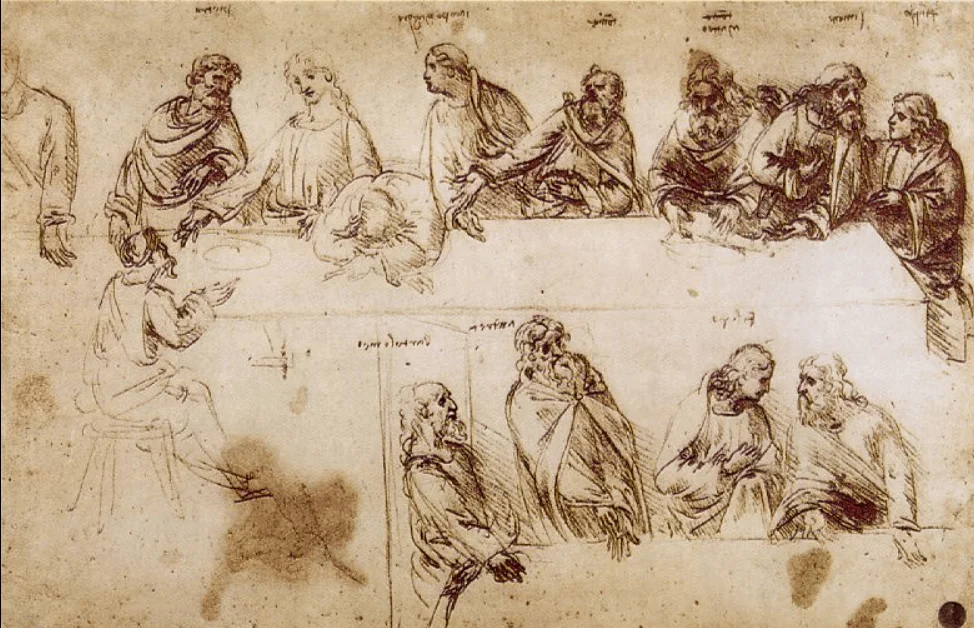
22. Judas is revealed as the betrayer
Jesus is explaining to Thomas and James the Greater, who are sitting at his left, that the betrayer will reach for a piece of bread at the same time that he does.
Judas seems to be distracted by the conversation between John and Peter, so he doesn’t see that Jesus is reaching for bread the moment he reaches for it as well.
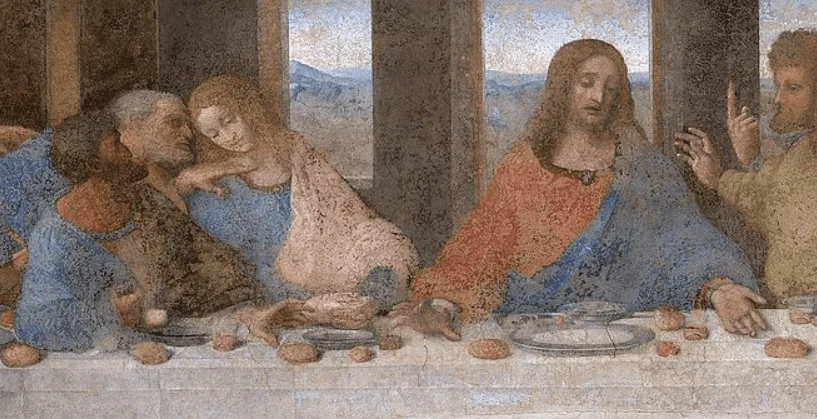
23. Judas tips over the salt cellar
Judas tipping over the salt cellar is a clear reference to the saying “betray the salt,” which means to “betray one’s master.”
This is exactly what is being depicted here.
24. Peter appears to be very angry
Peter seems to be very angry after hearing the news that Jesus will be betrayed, and he seems to be holding a knife as well.
Holding the knife is a reference to his violent reaction in Gethsemane during the arrest of Jesus, during which cut off the ear of Malchus, the servant of Caiaphas, the High Priest of Israel, who was one of the arresting officers.

25. Thomas is making a reference to his nickname
We all know that Thomas is called “Doubting Thomas,” which refers to his skepticism when he first hears about the resurrection of Jesus.
In the painting, he is clearly pointing his finger upwards which is a reference to the resurrection and his subsequent reaction.
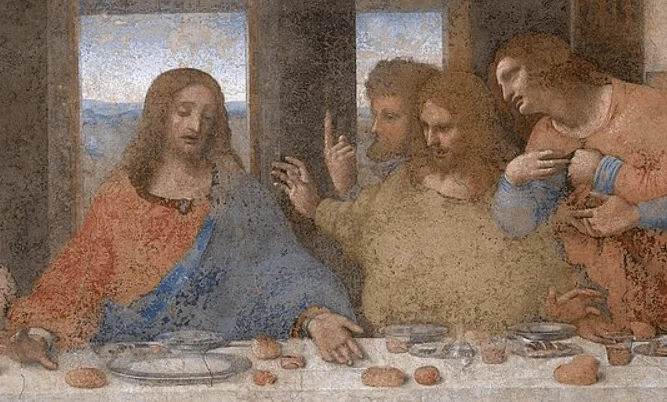
26. What are they eating exactly?
It’s clear that they are eating fish, but what type of fish isn’t too clear. Was Leonardo da Vinci giving us a message with this choice of food, which isn’t as described by the Evangelists?
If they are eating eel, it could represent faith in Jesus since “arringa” means “indoctrination” in Italian. If it’s herring, it’s the opposite as “renga” in Northern Italy means “he who denies religion.”
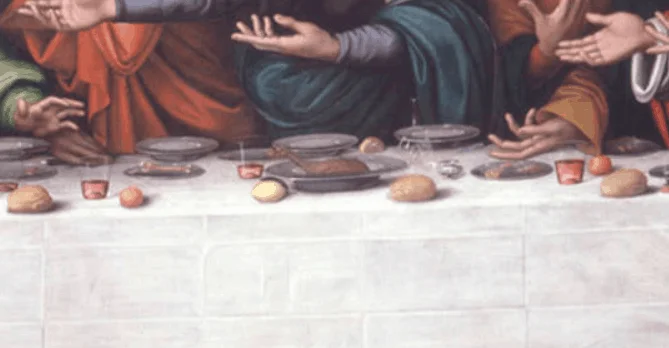
27. The angles of the painting are perfect
During the final restoration period, researchers discovered a small hole in the wall which used to contain a nail. On this nail, Leonardo Da Vinci attached a piece of string that he used to make marks in order to give the viewer the perfect perspective.
The angles and lighting to create this perspective draw attention to Jesus. His right cheek is located right at the vanishing point, which subsequently draws attention to the piece of bread, the clue that explains the dramatic scene.

28. The Apostles from left to right
According to a manuscript, which was found in the 19th century, we can accurately say who is depicted in the painting.
Below are the Apostles from left to right based on the position of their heads:
- Bartholomew
- James, son of Alphaeus
- Andrew
- Judas Iscariot
- Peter
- John
- Jesus
- Thomas
- James the Greater
- Philip
- Matthew
- Jude Thaddeus
- Simon the Zealot
